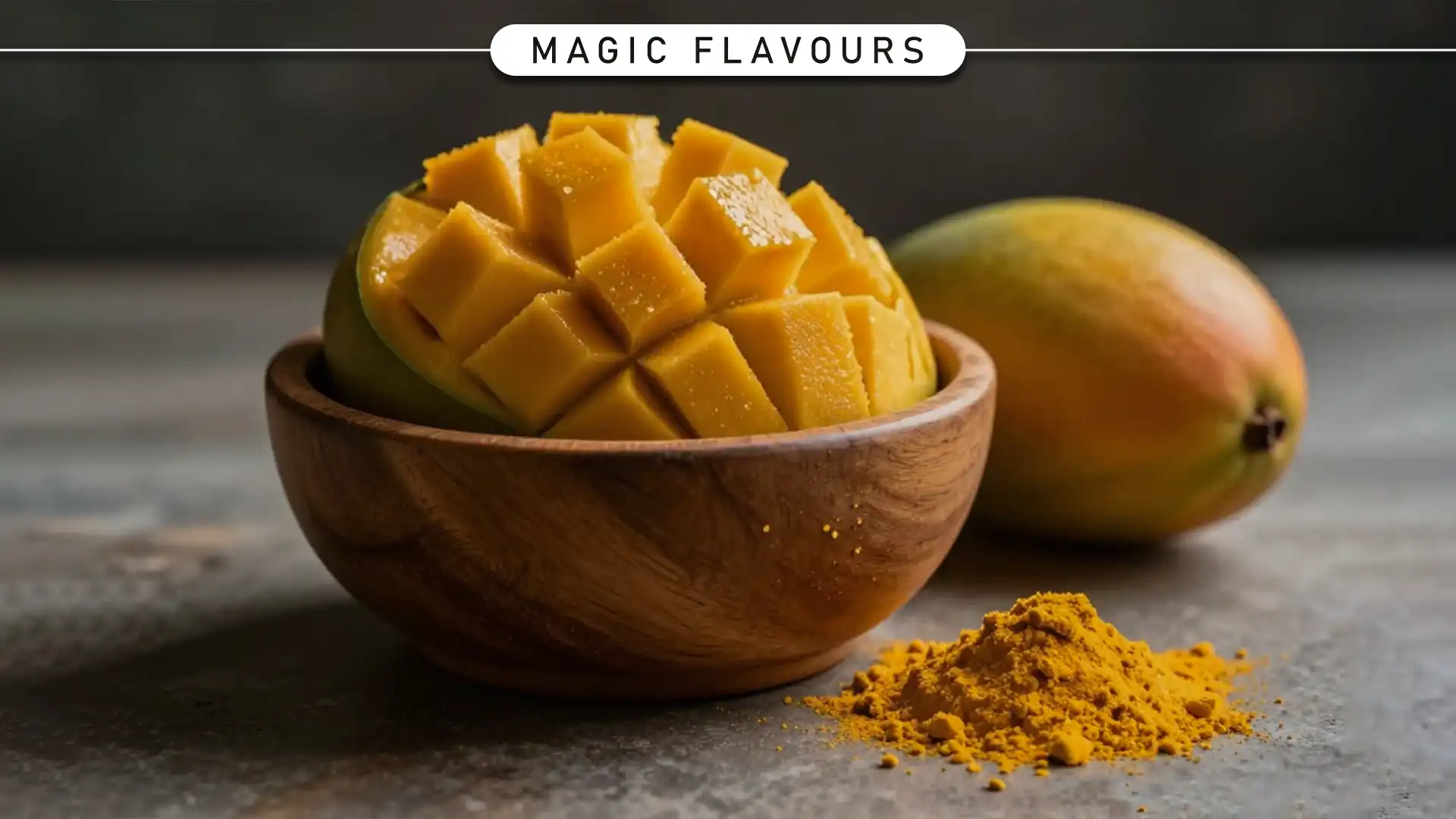1. What Is Mango Flavor Powder?
A Quick Definition of Mango Flavor
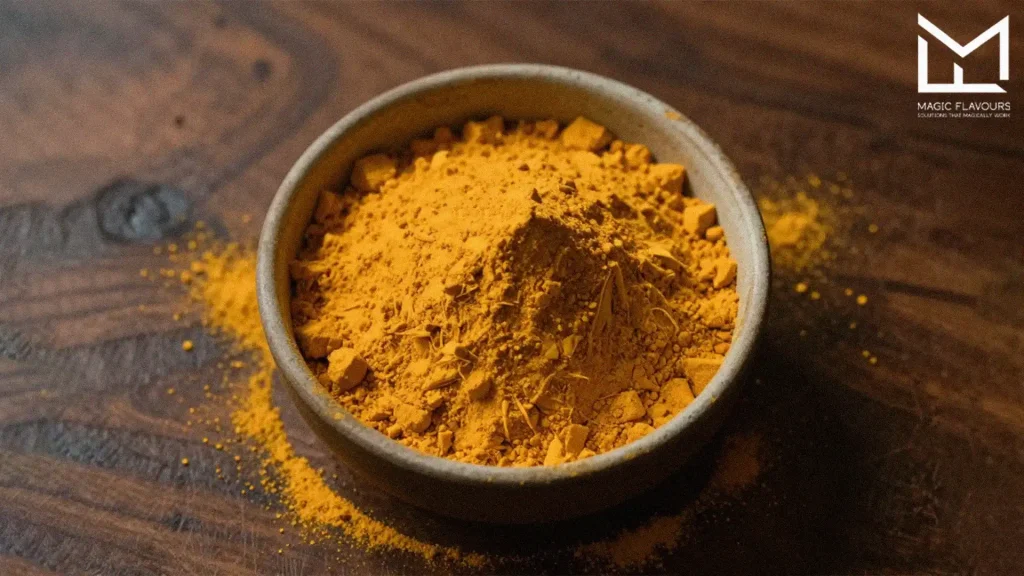
Mango flavor powder is a dry, concentrated form of mango taste used in food and beverage products. Because it’s shelf-stable and easy to mix, it’s popular in both home kitchens and commercial settings. Typically, it’s made by dehydrating mango puree or using flavor compounds that mimic mango’s tropical sweetness. Whether natural or artificial, this powder delivers consistent mango flavor in every spoonful. Thanks to its versatility, it’s used in drinks, desserts, and even savory dishes.
Why Mango Flavor is a Global Favorite
Across cultures, mango flavor powder brings sunshine and sweetness to everyday recipes. Because mango is beloved worldwide, its powdered form offers year-round access to its taste. In tropical regions, it’s used to enhance juices and frozen treats. Meanwhile, in colder climates, it adds uncommon flair to baked goods and smoothies. With its vibrant aroma and fruity richness, mango powder satisfies cravings and sparks creativity. That’s why it continues to grow in popularity across global markets.
2. What’s Inside Mango Flavor Powder?
Natural vs. Artificial Mango Flavor
Mango flavor powder can be made with real fruit or synthetic compounds. Because natural versions use dried mango puree, they offer authentic taste and aroma. These powders retain some vitamins and antioxidants, making them a healthier choice. Artificial powders, however, rely on lab-created flavor molecules. While they mimic mango’s sweetness, they often lack depth and nutrition. Choosing between them depends on your recipe, budget, and dietary needs. For richer flavor, natural mango powder is often preferred.
Common Additives and Their Functions
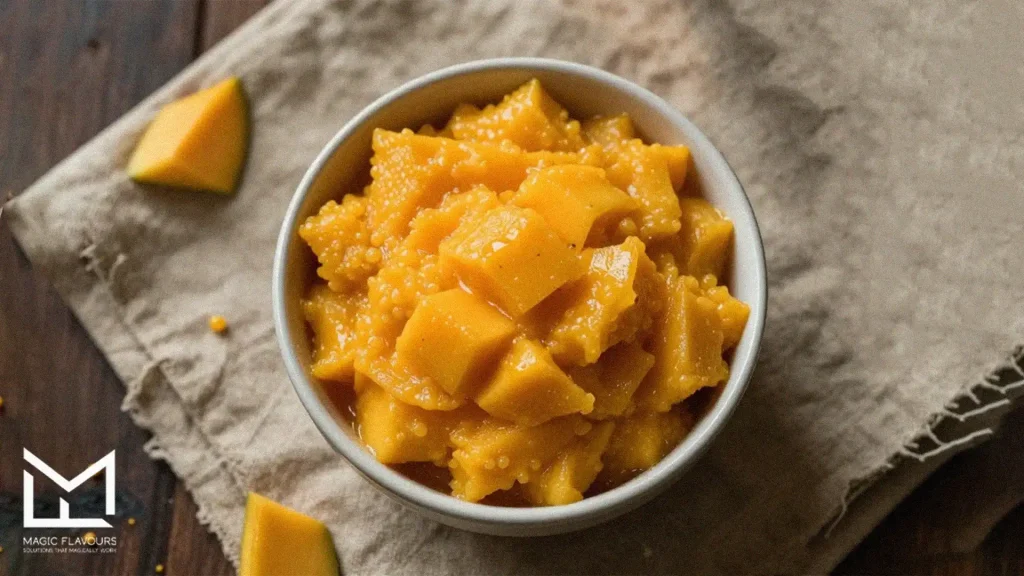
To improve texture and shelf life, mango flavor powder includes several additives. Because maltodextrin absorbs moisture, it keeps the powder dry and free-flowing. Citric acid adds a tangy note and balances sweetness. Anti-caking agents prevent clumping, especially in humid environments. Some blends include sugar or sweeteners to enhance taste. Additionally, stabilizers help the powder dissolve smoothly in liquids. These ingredients work together to ensure consistent flavor and performance in every use.
3. How Mango Flavor Powder Is Made
From Fruit to Mango Flavor Powder
Mango flavor powder begins with ripe, juicy mangoes harvested at peak season. Because freshness matters, producers select high-quality fruit for processing. First, mangoes are washed, peeled, and pureed into a smooth pulp. Then, the pulp is dehydrated using specialized drying techniques. This process removes moisture while preserving flavor and nutrients. Once dried, the mango is ground into a fine powder. With careful handling, the final product captures mango’s vibrant taste and aroma.
Spray Drying vs. Freeze Drying
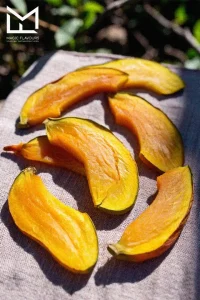
Two main methods are used to create mango powder: spray drying and freeze drying. Spray drying is faster and more cost-effective, making it ideal for large-scale production. However, it may slightly reduce flavor intensity. Freeze drying, on the other hand, preserves more nutrients and aroma. Because it’s gentler, it’s preferred for premium powders. Choosing between these methods depends on your priorities—cost, nutrition, or flavor depth.
Preserving Aroma and Taste
To protect mango’s tropical aroma, producers use low-temperature drying and airtight packaging. Because heat can dull flavor, gentle processing is essential. Some powders include natural flavor enhancers to boost mango’s sweetness. Additionally, antioxidants may be added to prevent oxidation and maintain freshness. With the right techniques, mango flavor powder retains its fruity charm from factory to pantry.
4. Where Mango Flavor Powder Shines
In the Kitchen: Baking and Cooking

Mango flavor powder adds tropical flair to everyday cooking. Because it blends easily, it’s perfect for cakes, muffins, and sauces. Whether you’re making fruit tarts or glazes, this powder delivers consistent mango taste. Additionally, it enhances frostings and fillings with vibrant color and aroma. Since it’s shelf-stable, home bakers love its convenience. With just a spoonful, recipes transform into sunny, mango-infused creations.
Beverage Applications of Mango Flavor: Smoothies, Juices, and Teas
In drinks, mango flavor powder offers instant refreshment. Because it dissolves quickly, it’s ideal for smoothies, juices, and iced teas. Whether you’re mixing with water or milk, it creates a fruity, tropical experience. Additionally, it pairs well with citrus, coconut, and herbs. Baristas and mixologists use it to craft mango lattes and mocktails. With its bright flavor, mango powder turns simple beverages into uncommon treats.
Commercial Uses: Snacks, Candies, and Instant Mixes
Food manufacturers rely on mango flavor powder for a wide range of products. Because it’s easy to store and measure, it suits large-scale production. It appears in candies, snack coatings, and instant drink mixes. Additionally, it enhances breakfast cereals and protein bars with fruity appeal. Its consistent taste and long shelf life make it a favorite in packaged goods. From vending machines to gourmet brands, mango powder plays a starring role.
5. Is Mango Flavor Powder Healthy?
Calories, Sugar, and Fruit Content of Mango Flavor
Mango flavor powder varies in nutritional value depending on its ingredients. Because some blends include added sugar, calorie content can rise quickly. On average, one serving may contain 20–60 calories. Natural powders made from real mango pulp offer more fruit content and fewer additives. However, artificial versions often rely on sweeteners and fillers. When choosing a powder, checking the label helps balance taste and nutrition. For healthier options, look for high fruit content and low sugar.
Vitamins and Antioxidants

Mangoes are naturally rich in vitamins A and C, which support immunity and skin health. Because drying methods affect nutrient retention, freeze-dried powders often preserve more antioxidants. Some blends also include added vitamins to boost nutritional value. Additionally, mango contains polyphenols that may help reduce inflammation. While not all powders retain these benefits, natural versions offer more than just flavor. Choosing nutrient-rich mango powder adds a wellness boost to your recipes.
Comparing Brands and Labels
Not all mango flavor powders are created equal. Because brands use different ingredients, reading labels is essential. Look for powders with mango listed as the first ingredient. Avoid blends with excessive sugar, artificial colors, or preservatives. Organic and non-GMO certifications signal cleaner sourcing. Additionally, some brands highlight vitamin content or fruit percentage. By comparing labels, you can find a powder that suits your health goals and culinary needs.
6. The Growing Popularity of Mango Flavor Powder
Vegan and Organic Options
As demand for clean ingredients grows, vegan and organic mango powders are gaining attention. Because they exclude dairy and synthetic additives, they appeal to health-conscious consumers. Organic powders use mangoes grown without pesticides, offering a purer taste and safer sourcing. Additionally, vegan blends often skip milk solids, making them suitable for plant-based diets. With clear labeling and ethical sourcing, these options are becoming pantry staples. Choosing vegan and organic means enjoying mango flavor with peace of mind.
Functional Additives (e.g., Collagen, Electrolytes)
Modern mango powders often include functional ingredients to boost wellness. Because collagen supports skin and joints, it’s added to beauty-focused blends. Electrolytes help with hydration, making these powders ideal for fitness routines. Additionally, some brands include probiotics or adaptogens for digestive and stress support. These enhancements turn mango drinks into health-boosting beverages. Whether you’re recovering from a workout or starting your day, functional mango powder offers flavor with benefits.
Packaging and Shelf Life of Mango Flavor
Packaging plays a key role in preserving mango powder’s freshness. Because exposure to air and moisture affects quality, resealable pouches are widely used. Some brands offer compostable or recyclable packaging to reduce environmental impact. Additionally, airtight containers extend shelf life and prevent clumping. With proper packaging, mango powder stays vibrant and flavorful for months. Choosing well-sealed, eco-friendly options supports both your pantry and the planet.
7. Sourcing Mangoes Responsibly
Fair Trade and Farmer Support
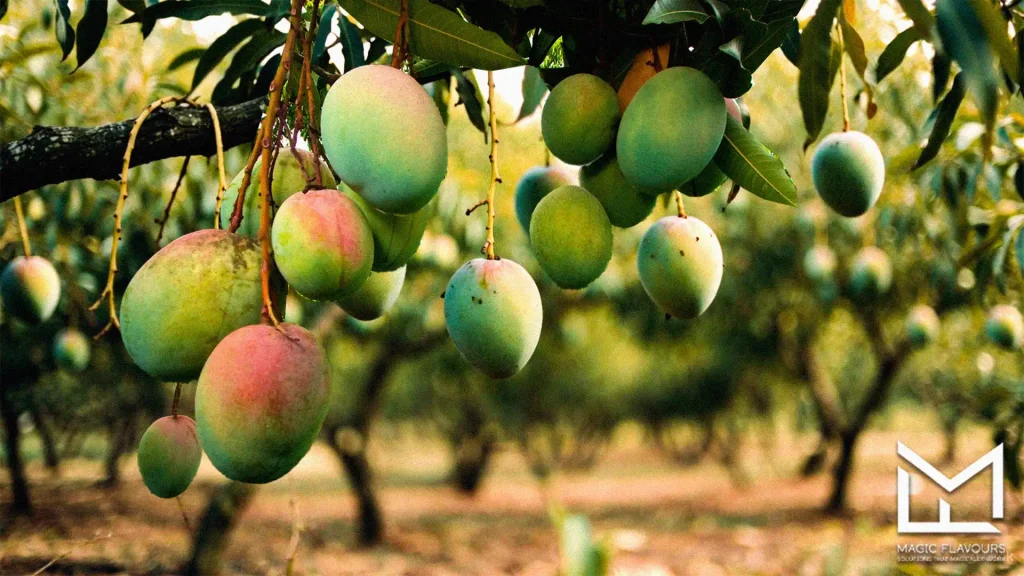
Fair trade mango sourcing helps ensure farmers receive fair wages and stable working conditions. Because mango farming is labor-intensive, ethical practices make a meaningful difference. These programs often invest in local communities through education and healthcare. Additionally, fair trade contracts protect farmers from market volatility. When brands choose fair trade mangoes, they support long-term sustainability and social equity. Consumers who buy these products help build a more just supply chain.
Environmental Impact of Mango Farming
Mango farming can affect ecosystems, especially in tropical regions. Because demand is rising, some farms expand unsustainably, leading to deforestation and soil degradation. However, sustainable practices like agroforestry and organic farming reduce environmental harm. These methods preserve biodiversity and improve soil health. Additionally, water-efficient irrigation helps conserve resources. When producers adopt eco-friendly techniques, they protect both the land and the fruit. Supporting sustainable mango farming helps preserve nature for future generations.
Certifications to Look For
Certifications guide consumers toward responsible choices. Because labels can be confusing, knowing what to look for is key. Fair Trade, Rainforest Alliance, and Organic certifications signal ethical sourcing and environmental care. These programs verify safe labor conditions, pesticide-free farming, and transparent supply chains. Additionally, non-GMO labels ensure clean ingredients. When shopping for mango flavor powder, checking for these certifications helps you choose products that align with your values.
8. How to Choose the Right Mango Flavor Powder
Taste vs. Price
Choosing the right mango flavor powder means balancing taste and budget. Because premium powders use more real fruit, they offer deeper flavor. However, they often come at a higher price. Budget-friendly options may rely on artificial flavoring and added sugar. While these work well for large batches, they may lack complexity. If you’re cooking for special occasions, investing in quality pays off. For everyday use, affordable blends still deliver tropical satisfaction.
Reading Ingredient Labels
Reading labels helps you understand what’s inside your mango powder. Because mango should be the main ingredient, it should appear first on the list. Avoid powders with excessive sugar, artificial colors, or preservatives. Organic and non-GMO labels signal cleaner sourcing. Additionally, check for fruit content percentages and added nutrients. By comparing ingredients, you can choose a powder that fits your health goals and flavor preferences.
Best Brands for Different Uses
Different brands cater to different needs. Because some focus on baking, they offer bold, concentrated mango flavor. Others specialize in drink mixes with smoother, sweeter profiles. For vegan or organic options, niche brands often lead the way. If you’re making smoothies or protein shakes, look for blends with added vitamins or electrolytes. Matching the brand to your purpose ensures better results and more enjoyment.
9. Mango Powder Around the World
Regional Preferences and Recipes
Mango flavor powder adapts beautifully to local tastes across the globe. Because mango is a beloved fruit in tropical regions, its powdered form appears in countless recipes. In India, it’s used in drinks like aam panna and desserts like mango kulfi. Southeast Asian cuisines blend it into sticky rice and fruit teas. Meanwhile, Western kitchens use it in smoothies, frostings, and baked goods. With each region adding its own twist, mango powder becomes a global favorite.
Historical Uses of Mango

Mango has deep cultural roots, especially in South Asia. Because it’s considered the “king of fruits,” it’s long been used in festive dishes and traditional remedies. Ancient texts mention mango’s cooling properties and digestive benefits. Over time, drying techniques evolved to preserve mango flavor year-round. Powdered mango became a staple in spice blends and travel-friendly snacks. Today, mango flavor powder carries that legacy into modern kitchens.
Surprising Uses in Savory Dishes
Though often associated with sweets, mango powder adds brightness to savory recipes too. Because of its tangy-sweet profile, it’s used in chutneys, marinades, and spice rubs. Indian amchur powder—made from dried green mango—is a classic example. It adds acidity to lentils, vegetables, and grilled meats. Additionally, chefs use mango powder to balance heat in spicy sauces. Exploring savory applications reveals its versatility beyond dessert.
10. Why Mango Flavor Powder Belongs in Every Pantry
Final Thoughts
Mango flavor powder offers convenience, versatility, and tropical delight in every spoonful. Because it’s shelf-stable and easy to use, it suits both busy kitchens and creative recipes. Whether you’re baking, blending, or seasoning, this powder delivers consistent mango flavor year-round. Additionally, it adapts to dietary needs and global tastes. With so many uses—from smoothies to spice rubs—it’s a pantry essential for flavor lovers everywhere.
Future of Fruit Flavoring
As food trends evolve, mango flavor powder continues to innovate. Because consumers seek healthier and more ethical options, brands are improving ingredients and sourcing. Expect to see more organic, functional, and globally inspired blends. Additionally, sustainable packaging and fair trade sourcing will shape future choices. With technology and creativity driving change, mango powder is entering a new era. The future promises more delicious, responsible, and exciting ways to enjoy mango.
